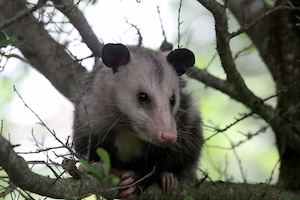
Several years ago, scientists decided to learn about the part different mammals play in the spread of the ticks and the disease.
They tested six species — white-footed mice, chipmunks, squirrels, opossums and veerys and catbirds — by capturing and caging them, and then exposing each test subject to 100 ticks.
What they found, is that of the six, the opossums were remarkably good at getting rid of the ticks — much more so that any of the others.
Scientists learned that opossums act like little vacuum cleaners when it comes to ticks – with a single opossum hoovering up and killing as many as 4,000 ticks per week.
The Virginia opossum is not the brightest of animals. When they are threatened, they pretend to be dead, which is where we get the expression “playing possum.” Sometimes, they do this in response to threats from oncoming traffic, which results in opossums becoming roadkill. So, the next time you see a opossum playing dead on the road, try your best to avoid hitting it. Because it turns out that opossums are allies in the fight against Lyme disease.
Possums, like many other small and medium sized mammals, are hosts for ticks looking for a blood meal. But opossums are remarkably efficient at eliminating foraging ticks.
“In a way, opossums are the unsung heroes in the Lyme Disease epidemic.”
Rick Ostfeld, author of a book on Lyme disease ecology and a senior scientist at the Cary Institute of Ecosystem Studies, explains…
“Because many ticks try to feed on opossums and few of them survive the experience. Opossums are extraordinarily good groomers it turns out – we never would have thought that ahead of time – but they kill the vast majority – more than 95% percent of the ticks that try to feed on them. So these opossums are walking around the forest floor, hoovering up ticks right and left, killing over 90% of these things, and so they are really protecting our health.”
So it’s in our best interest to have opossum neighbors. This means keeping their habitat intact with thoughtful land use planning, tolerating them in our yards, and, whenever possible, avoiding opossum collisions. With the huge rise in deer tick populations and the spread of Lyme disease, it’s time to welcome opossums into your yard.
Opossums are extraordinarily good groomers, which is just as well as they’re a magnet for black-legged ticks, which spread Lyme disease. Possums (Or opossums, same thing different name depending on location) are actually very clean animals, and groom themselves as thoroughly as cats. When ticks attach to possums, they’re promptly groomed away and eaten (possums are omnivorous, and insects are a normal part of their diets). It’s estimated that a single possum might “vacuum” up as many as 5,000 ticks a season…which serves to limit the spread of tick-borne diseases such as Lyme Disease and Rocky Mountain Spotted Fever. Additionally, opossums’ immune systems are incredibly resistant to disease, particularly rabies. They’re eight times less likely to carry rabies than other mammals.
 Did you also know that the opossum is the Earth’s oldest surviving mammal. It’s nicknamed the “living fossil,” as it has survived virtually unchanged since the Cretaceous/Paleogene extinction event 65 million years ago, which marked the end of the dinosaurs. And did you know that the possum has opposable thumbs on its forepaws and a “thumbs” on their hind feet. Oh, and it’s our only marsupial, having a pouch for its young.
Did you also know that the opossum is the Earth’s oldest surviving mammal. It’s nicknamed the “living fossil,” as it has survived virtually unchanged since the Cretaceous/Paleogene extinction event 65 million years ago, which marked the end of the dinosaurs. And did you know that the possum has opposable thumbs on its forepaws and a “thumbs” on their hind feet. Oh, and it’s our only marsupial, having a pouch for its young.
